|
|||||||||||||||||||||||||||||||||||||||||||||||||||
The two fictitious ads above are representative of the hundreds and thousands of ads motorcycle enthusiasts/collectors/dealers read. Specifically, they address two over-used and often widely interpreted concepts - "collectability" (not a word you'll find in the dictionary, but used here for lack of a better term) and value. After years of throwing these terms about with similar abandon—but all the time questioning their real meaning - I'll offer my thoughts to you on what these words mean to me, and what may be the basic causal factors in determining collectability and value. I have an old car. A 1959 Rambler American. Family hand-me-down, rebuilt flathead 6, chipped blue paint, reliable as the sunrise, and not very romantic (being a family heirloom, it stayed while the '66 Mustang GT convertible had to go... but that's another story!). Whenever I drive the car I receive comments of "Hey - that's really a collector car, huh?", or "1958? That must be worth a lot of money!" The first comment addresses how collectable the object may be; the second the value of the object. Let's look at these terms more closely... To Collect means literally to accumulate or to bring together. I'll look at the psychology of collecting in a moment, but suffice it to say that the [hobbyist] collector is striving to bring together a group of items, regardless of value, for some purpose. Collections of stamps, race cars, stuffed animals, pennies, and so on are all examples. Value, on the other hand, we'll call the monetary worth of an item (there are other types of value - sentimental, artistic, historical, etc - but we'll stay with monetary value only for the sake of this discussion). Certain factors combine to determine monetary value, and we'll examine these at length. Back to Collecting. I am certainly no psychologist, but I have long been fascinated by the motivations of collecting—from the joy on a child's face upon the obtaining the final penny for her coin collection to the anger between two adults fighting over the same Beanie-Baby. I would suggest that the desire to collect springs from one or more of the following drivers: 1)"Completion-compulsion", 2)aesthetics, 3)Investment-building, 4)Materialism, or 5)Re-living or re-inventing the past. By "Completion-compulsion" I'm referring to that innate human desire to complete a grouping through the acquisition of the missing pieces in the sequence. For example, the little girl with every penny from 1950 to 1983 except one from 1978; the man with each Ossa motorcycle from 1969 to 1976; the collector who wants one of every Norton engine displacement from 250cc to 850cc. Aesthetics are the appreciation of beauty, symmetry, design, etc., in a mad-made creation. How many of us have found ourselves falling in love with the line, colors, and shapes inherent in our motorcycles? We all have a natural love of beauty, and the love of this quality in man-made objects in general and motorcycles in particular is a key factor in motorcycle collecting. Investment-building is accumulating in the belief that the things you are accumulating will maintain or increase in monetary value, creating a reserve of value which can be withdrawn in the future. Materialism is the process of accumulating as much as possible for reasons such as ego and feelings of wealth or power. Probably deserves the negative connotation, and just drives up the prices! Re-living (or re-inventing) the past (usually childhood or youth). Arguably the most interesting of the driving factors behind collecting. When I was 13 years old, my otherwise conservative and careful father and mother, in a moment of completely incomprehensible erratic thinking, elected to buy me a 1971 100cc Kawasaki. It became the center point of my life for 3 years (till the 1974 KX125). Now, 30 years later, nearly every early-70s Kaw enduro—and about every other Japanese small-bore enduro—gives me an immediate image of lazy, simple Pennsylvania afternoons with other boys, of childhood friends and adventures, of fun and an unlimited future—in short, the little Kaw enduro bikes I have (to include my first) are little icons to the most pleasant memories I can recall. I was lucky—perhaps to some these bikes would represent the fun they didn't have or no longer enjoy. Furthermore, I found myself craving all the bikes I, also, didn't have; to a 12 or 13 year old boy in 1972, a CZ or Norton was something you only saw in the pages of DIRT BIKE or CYCLE WORLD magazines—they were no more real to us than the prospect of talking with the President that morning, flying in space, or having lunch at the Taj Mahal. So, when many of this generation came into careers with some discretionary income, they bought the machines they wanted back then but couldn't have. Prime examples of both re-living and re-inventing the past are the old car guys, whose nostalgia with the 40s, 50s, or 60s is an undeniable aspect of their old-car-centered activities. That about covers the motivations to collect that I'm most familiar with. Now let's move to value and what determines it. The value of an item or service is—for our purposes—its monetary worth, determined by how much that item or service is wanted by buyers (and therefore how much they're willing to pay). The 7 determinants of value (and collectability) I propose are specific to here to older motorcycles, but I believe are generally applicable to any "secondary" market (meaning sold again after the initial sale; to include antiques, used cars, art, etc.); I believe you could substitute painting, furniture, or automobile for motorcycle below, and the questions would be equally valid. The determinants are:
"Was/is the motorcycle rare or of very limited production?" This category includes both machines that are rare now because of limited production then (factory racers, Bimotas, Heskeths) and those that are rare now because there just aren't any more around despite the many that were made (Indians, certain Hondas, and passenger pigeons). By definition, a factory racer was made in small quantities for sponsored riders, and was sometimes even slated for destruction following its racing career. Not surprisingly, any factory racer now is wanted in excess of supply, and their values tend to be the highest of all old motorcycle values. Likewise, antique motorcycles (circa 1910-1920) are often extremely rare relative to demand for them, and tend to remain in the lofty tens-of-thousands-of-dollars cost zone. "Does the motorcycle have historical significance?" A friend of mine was given a 1978 Honda CM400. Now, this motorcycle doesn't quite ring the bell in any other value-determining category that I did or will discuss; however, this motorcycle is unique in that it was [50s Rock-n-roller] Chuck Berry's CM400, and given to my friend by Chuck himself. All this doesn't make the motorcycle any better than any other motorcycle, but it does lend a certain interest to the machine that is undeniable. Elvis' Harleys are another example. Non-motorcycle examples of such historical significance include the recent auctioning of jewelry, a rocking chair, and other personal items owned by Jacquie Kennedy; baseballs used in important games or hit by stars; and every other conceivable item used or owned by a luminary. Racing history of motorcycles also greatly enhances interest and value; Harley-Davidson XR-750s always command great value, but Mert Lawwill's XR-750—wherever it might be—would certainly trump a standard XR-750's value. Even the knowledge that machine-X was raced by this or that average person in that or that year adds some element of interest to a motorcycle's pedigree (and probably value). "Is the motorcycle useful now?" Usefulness (utility, as an economist might say) almost always enhances value. A motorcycle that is beautiful/unique/rare/etc… is one thing, but a motorcycle that is all those things and can be ridden reliably to work or for pleasure is probably more desirable. The concept of utility being a determining factor in value is most vivid to me in the example of vintage motocrossers; up to a few years ago, when AHRMA vintage motocross excluded all machines manufactured after 1974 from vintage competition events, a 1974 Maico of any displacement was a highly-valued machine among vintage-MX enthusiasts. At the time, a like-condition 1975 Maico, being illegal for vintage competition, sharing few parts with its pre-1975 brothers, and being essentially an outmoded old dirt bike with no suspension, was worth practically nothing. (Of course, aesthetically, they are very similar, and if aesthetics are a prime motivator for a particular collector, this anomaly can actually work to the collector's advantage. After all, if the collector doesn't plan on racing it, isn't buying it as an investment, and just wants to have cheap fun restoring/admiring/tinkering with it, then a "soft" market such as the recent post-1974 example is a benefit.) "Is the motorcycle Conditionally-collectable?" I picked up this terminology some years ago from a now-forgotten source, and may have taken some excessive license in applying it. Whatever—the meaning is this: No matter what the motorcycle is, if it's nice enough it's worth something!" For example, back to my 1959 Rambler. It isn't sexy, it isn't fast, it isn't that well made; in fact, it doesn't have any great redeeming feature as a car… but it is a reliable, well-maintained unique automobile in very good condition (perhaps one of the best in the country, for that matter), and that means something. Lots of old motorcycles fall into this category. The 1966 Yamaha 125 street twin with 17" tires in as-new condition kept by old Mrs. Smith in her heated garage down the street may not be Elvis' Harley, but there is an undeniable attraction to any motorcycle in this condition. Other factors: Fad, fashion, current events, etc. Over time certain styles, modes of behavior, expressions, etc. Become popular, and then evolve into other manifestations. This might be considered "fashion"; "fad" might best be considered an especially short fashion trend, devoid of any similar fashion predecessor or follow-on. As I write this, low-rider jeans, halter-tops, and high heels are in fashion for the American woman, and Pokeman items are way past their prime as a fad for the kids. In motorcycling, anything Harley remains comfortably enshrined in a nearly-20-year Harley-Davidson fashion dominance. Italian motorcycles are riding a more recent and less noticeable fashion trend (perhaps partially due to their prominence at the Guggenheim "Art of the Motorcycle" show of 9 years back). Events, likewise, make a particular machine more "in-fashion" or at least more recognizable; a particular brand appearing in a movie (BMW, for example), the issue of a poster showing Marlon Brando on a Triumph, a National Geographic article on Lawrence of Arabia (who met his end on his beloved Brough-Superior)… Any such publicity can't help but perk interest in the subject machine and therefore enhance value in some way, however small or of short duration. One last influence on value which loosely fits this category is the phenomenon of increased value by association; that is, because a like item sold for a certain amount on a previous occasion, then a similar item should (particularly from a seller's perspective) be worth the same or more, now. Perhaps this is a real-life application of the old Geometry theorem of "If A=B, and B=C, the A=C". The occasional downside to this influence is that because a 10-point example of a certain machine sold at auction in Southern California to Jay Leno 6 months ago, the seller you're working with has mentally catapulted to the belief that the far homelier example he's got for sale to you is worth at least that much, even as he shines a flashlight on this pigeon-dropping encrusted, rusted, flat-tired example in the corner of a shed in Podunk, West Virginia. The guidelines I've presented in the previous paragraphs are just that—guidelines. Many exceptions to these certainly apply, and perhaps you'll be able to figure out the missing "why" where I haven't. To begin with, I can think of any number of motorcycles which meet one or more of the basic value-influencing points I've discussed, yet are generally low-valued. For example, the Austrian Puch is an example of exceptional design, craftsmanship, and quality components… Benelli street and minibikes were of excellent quality and (in the case of the minis) wanted and owned by many in the early 70s…Harley-Davidson JD models from the late 20s are wonderful motorcycles in every respect, yet even at the $10,000 mark they seem somewhat below the value of similar motorcycles of other early makes…each of these examples—generally speaking—defies the points I've presented for determining value/collectability for some reason. Another point to consider when assigning values to motorcycles is "Generation" preferences; that is, each generation has machines that they favor, from their generation's experience (usually dating from the time they were young). This tends to push the value up from the "Was it wanted when new?" standpoint, but be advised that when a particular generation's influence passes, values may drop. As an example, consider the Ford Model-T. Values in the early 1980s (when the World War II generation was nearing 60 and greatly influenced the market) hovered around $20-25,000 for a good example—in 1980 dollars! Now the same cars can be seen for sale for $7-9,000. Sadly yet predictably, that grand generation is passing away, and few others share their passion for Model-Ts. My generation seems to find them unattractive, slow, and definitely not sexy …frankly, we're just not interested and aren't going to pay much money for Model-Ts! Now, to extend the analogy to motorcycles, I'd say that you might not want to invest your retirement savings in Whizzers, Cushmans, or 1960s Italian motocrossers—all machines with somewhat narrow appeal to a specific generation. Though prices may have been high (as in the first two examples) or are getting high (as with a certain few motocrossers), the values on these machines will more than likely fade as the generations fade from economic prominence. The 17-year-old dirt bike rider down the street probably has no idea what my Maicos are; would consider them odd, ugly, and useless; and certainly wouldn't pay good money for them. (NOTE: If I were to invest in old motorcycles from a profit-making standpoint—which I don't—I'd put my money in the proven "Blue Chip" commodities: American antiques, early (pre-1965) race bikes, and older exceptional bikes (MVs, Vincents, Crockers, etc.). And, from an investment mindset, I'd avoid buying many of those bikes that I personally love and can afford—European motocrossers, Japanese enduro motorcycles, and later British bikes.) Curiously—and this is particularly interesting to us Dirt Bike types—certain vintage dirt bikes have risen in value exponentially over the past decade. Along with the usual "high dollar" bikes (Rickman and other early 1960s MX 4-strokes, side-pipe CZs, works bikes, etc.), the rise in selling prices of all pristine original or restored bikes are very high, and Maicos in particular have hit the stratosphere…and even as a Maico collector I find myself somewhat vindicated, yet still scratching my head in attempting to understand this. Recently two 1974 average-condition MX bikes came up for sale on eBay—one a 1974.5 Maico 501, and the other a 1974 Husky 400. Both were from the same owner, and in about the same condition—both rough and mostly complete, with the Husky slightly better than the Maico if anything. The Maico eventually sold for about $5,400, while the Husky went for about $500—one tenth of the price of the similar Maico! Less rare? Well, of course, but ten times less desirable?? Such purchases bring to light the phenomena of auction bidding gone wild (reminds me of racing, when you want to pass that guy so badly that you'll blow the motor to win and passion trumps rational thinking for a few moments), and eBay can be just that. Is eBay affecting the entire universe of selling and buying? Yes. With respect to our own interests—old motorcycles—we can say that the good part of eBay (and Craig's List and other on-line selling services) is that as buyers we now have infinitesimally greater access to what we might want…on the bad side, we now must compete with like-minded potential buyers across the world. As for me, I kinda like the old days of the great Barn Find, and good deals at swap meets…but that's just me. That's about it. I leave as a postscript a matrix that can use for assigning objective numbers to value, along with a couple examples. But, more importantly, let me leave you with two suggestions:
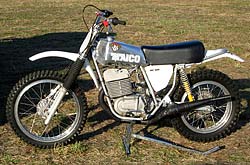
Notes: Cheers, *** |
|
||||||||||||||||||||||||||||||||||||||||||||||||||
|
|||||||||||||||||||||||||||||||||||||||||||||||||||




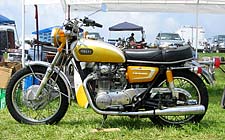
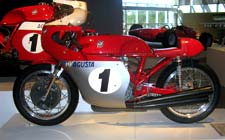
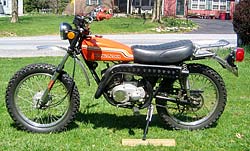 "Was the motorcycle wanted when new?" refers to the degree of interest the product commanded when originally marketed. Furthermore, if one wanted or in fact did own the machine in earlier times, that person is likely to have positive feelings towards purchasing the machine when confronted with the opportunity to own it today. Interest in the late 60s/early 70s British bikes and Japanese enduros is peaking now, due to the baby-boomers' warm, fuzzy memories of their youth meeting maximum discretionary income and the midlife crisis years. And that interest directly affects the value of the machines. Everyone seemed to want a Triumph Bonneville in 1970—and they'd like one now, too; hence, the machine's value is high. Fewer people owned or wanted a Royal Enfield in 1970 (or want one now), and the value of that machine—regardless of relative quality—is less than the Bonnie (all other things being equal).
"Was the motorcycle wanted when new?" refers to the degree of interest the product commanded when originally marketed. Furthermore, if one wanted or in fact did own the machine in earlier times, that person is likely to have positive feelings towards purchasing the machine when confronted with the opportunity to own it today. Interest in the late 60s/early 70s British bikes and Japanese enduros is peaking now, due to the baby-boomers' warm, fuzzy memories of their youth meeting maximum discretionary income and the midlife crisis years. And that interest directly affects the value of the machines. Everyone seemed to want a Triumph Bonneville in 1970—and they'd like one now, too; hence, the machine's value is high. Fewer people owned or wanted a Royal Enfield in 1970 (or want one now), and the value of that machine—regardless of relative quality—is less than the Bonnie (all other things being equal).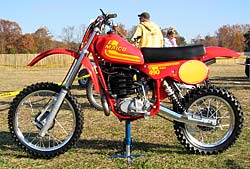 "Was the motorcycle exceptional when new?" By exceptional I mean that the machine stood out above its contemporaries by being especially noteworthy in one or more of the following areas:
"Was the motorcycle exceptional when new?" By exceptional I mean that the machine stood out above its contemporaries by being especially noteworthy in one or more of the following areas: